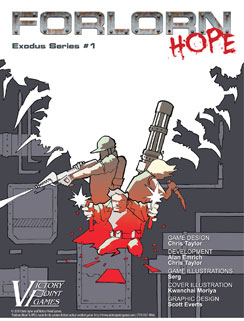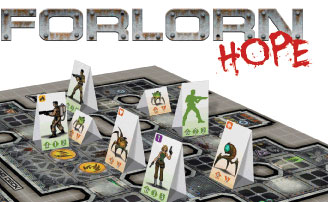Review
Forlorn: Hope
Designed by Chris Taylor
The Spin: Low –complexity, quick-playing “game of tactical combat between a squad of human Space Marines and a nearly unlimited horde of hostile alien Xenos aboard the claustrophobic space station, Hope.”—Forlorn: Hope “box” cover
 Not sure why, but I really love this cover art.
Not sure why, but I really love this cover art.
If you are a older gamer, it will be hard to read the above description without thinking about Games Workshop’s Space Hulk or possibly Steve Jackson’s Awful Green Things from Outer Space or maybe even Task Force Games’ Intruder. The good news is that while Forlorn: Hope shares elements with all of the above games, it still manages to maintain its own identity. Better yet, it turns out to be one of the better examples of the Bug Hunt sub-genre, better even in some ways than the aforementioned classics.
Forlorn: Hope’s basic “plot” is nearly identical to Space Hulk’s. Various missions give two players the opportunity to run a group of high-tech marines against a swarm of low-tech but vicious aliens in the narrow corridors of a space station. Also like Space Hulk, Forlorn: Hope has marine movement and attacks tied up in an action point system—though there is an important difference. Here, the marine player generates a set number of action points for his entire squad at the beginning of each turn instead of having each individual marine with his own set of action points. Since a single marine can be activated as many times as the player has action points, the marine player has the option of playing it safe and advancing the whole squadron as a unit or loading all the action points on a single marine which creates a kind of kick-ass, super-soldier hell bent on completing the mission’s objective. In our games, the marine player often was forced into both strategies—playing it safe until the squadron was nearly wiped out and then loading up one marine for a heroic last run.
 Kick'n it old school (and by "it," I mean alien ass)
Kick'n it old school (and by "it," I mean alien ass)
The Xeno player isn’t restricted by an action point system. In fact, every Xeno gets to move and attack every turn. The big limiting factor for Xenos strategy seems to be the relative lack of ranged attacks and the fact that the creatures must stick to the move-first, attack-last order. Since having an alien next to a marine causes a “grapple” which keeps the marine from moving, if a Xeno could attack and kill one marine and then move into grappling position on a second, it could be devastating. It is one of those simple rules that change a game tremendously, and one of the many signs that Forlorn: Hope is a well-thought-out game.
Clever Elements: Other than how well the game’s narrative develops as the game progresses, my favorite game play feature is the mutation of the Xenos. At the beginning of a scenario, the Xeno player drops a certain number of eggs onto the map from roughly a foot above the table. When these eggs “see” a marine, they turn into a hatchling at the end of the round. This hatchlings can then be mutated through the use of cards or by eating the corpses of marines, eventually becoming one of the two powerful special aliens—the Blaster and the Warrior. I really liked watching that process develop—more so when I wasn’t playing as the marines.
Balance: I haven’t played anywhere near enough games yet to comment on the overall balance of the game, but it seems the aliens have a real advantage in the scenarios that allow them to spawn drones randomly throughout the game. In one game, my brother kept rolling 3’s on his d3+1 spawn rolls and got to place four drones at the end of nearly every round. The automatic grapple between aliens and marines made for a nearly impossible-to-run gauntlet as I tried to get a laptop with vital information off the derelict space station. Still, even in that game, I was two action points away from the win—with my final marine killed right next to the airlock having used up all of her action points making the run.
Components: I mentioned three games in my opening to this review, Forlorn: Hope’s components are better that one of them: Intruder, much worse than another: Space Hulk, and about the same as the third: Awful Green Things from Outer Space (minus the box). Like all Victory Point Games releases, Forlorn: Hope has production quality about one step above a DIY, PDF game. Well, two steps really: the art is wonderful and the counters are pretty, well-designed and double-sided. Otherwise, the map is on two pieces of thin card stock and the matching Player Aid sheet is equally flimsy. The game does come with card stock standees for the aliens and marines, but we didn’t bother to cut them out because we didn’t have any clear bases to clip them in and they seemed prone to flip over and shift on the map without them. That said, the graphic design of the game is clean and easy on the eyes. I never felt gypped by the component quality or confused by icons.
Shelf-life: Is Forlorn: Hope a good value? Well, there is a lot of game in the 8 x 11 plastic bag. There are multiple scenarios and a variant for solitaire play. The game plays quickly and really called to me for back-to-back plays. I’m a huge fan of Space Hulk and I have the ridiculously fancy new edition, but I expect Forlorn: Hope will see more table time the SH in my future due to its portability and fast, simple game play.
Final Score: 7.5/10
Note: Check out the rest of Victory Point Games vast library here.